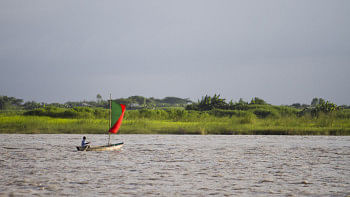For most people living in Bangladesh, or those flying in from abroad on a holiday, you will probably be excited about visiting Lalbagh Fort, a "popular" Mughal heritage and an iconic landmark of the country's capital, Dhaka. However, not far from the city — less than a three-hour drive from its international airport — lies Idrakpur Fort, which is a peaceful and less explored spot for tourists, a gem for curious history buffs, a small but awe-inspiring piece of architecture.
Located in Munshiganj, the 17th century river fort is beyond the hustle and bustle of the more common tourist spots, and gives a rather different experience compared to the grander Mughal edifices that are spread all over the Indian subcontinent.
That's why you should have this on your itinerary if you are exploring Bangladesh!
The man and the monument
Let's first travel back in time and set a context. Historians believe that Idrakpur Fort was most likely built by Mir Jumla, a Mughal subahdar (viceroy/governor) of Bengal, possibly around 1660 AD. He ruled under Emperor Aurangzeb.
The self-made man of Persian origin had a glorious career. Mir Jumla assisted Aurangzeb in solidifying his throne and continued military campaigns even when he was the governor of Bengal.
During his tenure in Bengal, attacks and raids by pirates was a huge concern. Hence, this river fort was built to counter the advance of the pirates or to keep them away. Idrakpur Fort is in fact a part of a larger system of river forts that collectively formed a defence mechanism against pirates — protecting water routes and safeguarding Dhaka.
If you delve into its geographic history, it will not come as a surprise that the fort originally stood on the bank of a river.
A picturesque river fort
The first glimpses of the beautiful brick fort as seen from the street are enough to set a feeling of antiquity: a circular raised platform, bastions, and a simple, but elegant entry gate are some of the first features you see that put you in the mood to explore the compound.
As you step inside, you will quickly notice that the overall compound is rather serene — a small pond surrounded by trees; scrubs and plants dotted around, and although there are many visitors, it is not overcrowded.
You will soon come across a set of stairs, which leads to a graceful-looking gate. This will essentially take you on to the top of the large, round platform, a watchtower of sorts. There, you are surrounded by circular battlements marking off the circular platform; basically, parapets or walls with holes for weapons.
This is where you let your imagination soar, as you may picture soldiers or guards of olden times looking out onto the waters — monitoring ships, or even launching attacks at enemies.
There is a narrow flight of stairs on one side of the round structure. Within the compound there is also a tiny museum that has been annexed.
Idrakpur Fort is neither a large, grand fort, nor is it a common tourist spot. In that sense, it is "far from the madding crowd," and its beauty lies in the tranquillity, elegant architecture without being presumptuous, and the notion of being a Mughal outpost.
These make Idrakpur Fort so special and memorable!
A little off the track
If you are planning to visit this fort, we recommend exploring two other spots that are in close vicinity:
Baba Adam's Mosque pre-dates Idrakpur Fort by almost two centuries! The pre-Mughal structure was built in 1483 and belongs to the Sultanate era of Bengal. Baba Adam, the saint after whom the mosque takes its name, lies buried in a mausoleum in front of it.
Mirkadim Bridge is a beautiful Mughal-era bridge, and if Idrakpur Fort has sparked an interest in Mughal architecture, visiting this structure will be worthwhile. A great way to view the bridge is to take a boat at the creek and sail under the arched gateway-like structure.
Travel essentials
How to go: The best option is to rent a car from Dhaka and make a daytrip to Munshiganj. From Dhaka, let's say from Hazrat Shahjalal International Airport, it will take you approximately 2.5 hours to reach Idrakpur Fort. The other two aforementioned spots are in a 30-minute radius by car, and are quite near to each other. Prepare to haggle with the rent-a-car company when booking. Generally speaking, the fare of a sedan should not be more than Tk 5,500.
Here is a link of Google Maps, with the three destinations pinned
Visitors' info: Idrakpur Fort is closed on Sundays and on the first half of Mondays. Ticket prices vary, depending on your nationality. The maximum amount to be paid is Tk 300, for visitors outside the SAARC region. The other two sites (Mirkadim Bridge and Baba Adam Mosque) do not require any tickets and are free of charge. But if you want to take a boat ride, for around 15 minutes on the creek under the bridge, the ride may cost you about Tk 200, but it largely depends on how good you can bargain!
Additional things to know: Although there may be not many foreign travellers there, the region overall is not far from the capital city of Bangladesh, is well connected to it, and is not at all a remote area that would lack the basic amenities needed for a daytrip. Note that it does get hot and humid in summer, and therefore, carry plenty of water with you, along with an umbrella or cap.














Comments